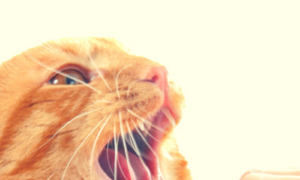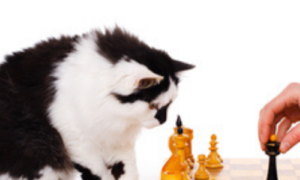By Darcy Lockman for The Daily Cat

Thirty-two-year-old Brooklyn, N.Y. cat owner Amy Morgan can name the most prominent behavioral characteristics of her seven-year-old calico cats, Mashy and Ruki, without thinking twice. “Mashy is uppity, stubborn, verbal and affectionate,” she says. “He’s on top of me as soon as I wake up every morning, kneading my blankets and laying with me.” Then there’s Ruki: “He’s an entirely food-motivated idiot savant. He knows how to turn door knobs. And when the bathroom door is closed, he tries to get in there through the kitchen cupboards, which is impossible, but it’s a good guess given the layout of the apartment. He’s also a bit of a bully toward Mashy.”
What Morgan cannot state so easily is how her cats developed the pronounced personalities they have today. But she is able to hazard a guess. “Mashy was abandoned by his mother so maybe that’s why he’s so clingy. And Ruki may eat so much because he was the runt of the litter, so when he was nursing it was hard to get enough.”
Cat behaviorist Jackson Galaxy of Redondo Beach, Calif., agrees that Morgan may be onto something. “As with people, multiple factors play into cats’ personalities,” Galaxy says, “and you can never know for sure what kind of cat your kitten will grow into based solely on genetics or environment. I’m a tall, bald, tattooed guy and people assume that I’m going to be a dog person. You can’t always make those kinds of generalities with cats, either.”
Keep that in mind as Galaxy discusses some general likelihoods of cat character.
Nature
Not surprisingly, genetics play a role in cat personality. Galaxy says some guesses can be made about the kind of adult cat a kitten will become based on its breed. He has found that Asian breeds, like Siamese cats, tend to be very sensitive to stimuli, which owners misperceive as neuroticism due to their quick response to sounds and rapid movements.
Tortoiseshell cats (cats that are mostly black and orange) tend to be high strung, tabbies, on the other hand, are known for being playful and assertive and Persians are often thought of as docile. But, adds Galaxy, “These traits are tendencies. They’re not what make cats individuals.”
Nurture
Your cat’s environment also helps to shape its character. The crucial phase of development for kittens is between two and nine weeks. If a cat is hand raised from very early on, they are going to encounter other cats and have all kinds of communication problems, Galaxy believes. “They won’t know about hissing and meowing. They’ll have to learn how to talk cat.” Felines that aren’t around siblings don’t understand what inhibited play is, because they have never been bitten by another kitten as a cue to back off. “With siblings, you learn the social rules. Kittens raised solo are socially stunted.”
Similar difficulties can arise in kittens that spend their critical phase with all cats and no people. If they don’t have human contact during that phase, they will have a different kind of social difficulty, according to Galaxy. “They perhaps will never feel completely comfortable around humans.”
The age at which a male kitten is neutered can also affect its personality. “If you do it early on, at eight weeks to three months, you’re not going to see these dominant male traits like territorial marking come out. If you wait longer, say six to eight months — which I don’t recommend — they’ll still develop the male sexual personality traits, though they’ll be pseudo-sexual.”
The X-Factor
Additionally, there is a mystery of personality in every species, from feline to primate. “What makes me different from you? I take a cat’s history when I go into a home to work, but I also spend time getting to know it,” Galaxy says. “Not to do that would be insulting. The same should go for you when you adopt a cat. Know its background. And then get to know the cat.”
The next step: accepting the cat for itself. “I get a lot of calls from people who want me to change their cat,” says Galaxy. “They hope I can turn it into an animal that wants to be held or picked up, when really a cat expresses affection by rubbing up against a human or exposing its stomach. I tell those clients, ‘If you want a cat that you’re going to be able to hold, then adopt another cat.’ You can’t change its stripes.”
How To Bring Out Your Cat’s Best
Galaxy emphasizes that accepting your cat does not mean allowing a once-abused, newly adopted cat to spend its life hiding under the bed. “That’s not a healthy, quality life. We can help that cat to trust us, to come out from its isolation.”
You can also encourage the traits you find most endearing in your cat by rewarding those traits. “I love my cats’ sociability,” Galaxy says. “When I have company over and they come out on their own, I immediately give them a treat. This works best if they’re food motivated. Clicker training — or associating food rewards with the noise of a clicker so that eventually the sound is experienced as praise — is a great way to encourage your cat to be more of the cat you want it to be.”
Of course, sometimes the traits you don’t want to encourage are the ones you can’t resist. “We try to punish Ruki for bullying Mashy,” sighs Morgan, “but he is so endearing in his fat dumbness that we end up laughing. At this point, I think he gets that we think he’s adorable.”
Darcy Lockman is a Brooklyn, N.Y.-based freelance writer and frequent contributor to The Daily Cat. Her work has appeared in publications such as the New York Times and Rolling Stone.





